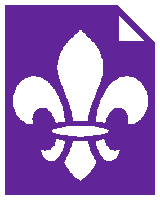Preparing for a Klondike Derby
Organizing and participating in a successful event
Preparing the Course
The route for a Klondike Derby should be varied so that it tests the adaptability of the Scouts. The course should have some hills that have to be climbed and descended including at one up and one down that are really steep. This requires the Scouts to use their creativity with ropes and possibly pulleys to move their sled. If the snow on the trail is very deep, it is a good idea to have a few people walk it with snowshoes to pack it down somewhat.
The event stations should be spread out along the route, preferably in relatively sheltered spots so that those in charge of the stations don't freeze. Events that take longer to complete should be able to handle more than one patrol at a time to avoid lineups. Markers for the event stations and the route should be put in place the day or weekend before the derby at a Scouters' walk-through of the course. Consider having a mid-morning station where the Scouts are served hot chocolate (but not so hot that it burns!). Dehydration is a risk in the winter time, especially during times of exertion.
Scouters who are running the first few events must be ready for patrols that are ready to start right on time. They should ensure that another Scouter takes care of any last-minute issues with their own Scouts, such as registration.
When gold-seekers came up the Chilkoot Pass, they were inspected by the North West Mounted Police before being allowed entry into Canada and the Yukon. Those that did not have enough supplies where turned back for their own safety. So it should be at a Klondike Derby. Any Scout in running shoes or any sled lacking a brake rope must not be allowed to participate in the Derby until they correct whatever is unsafe. The first event, therefore should be this inspection. Why not try to make some NWMP uniforms for authenticity?
Preparing the Scouts
One of the important features of a Klondike Derby is that the Scouts participate as a patrol on their own, relying on each other, building and testing teamwork. Scouters or parents must not accompany their Scouts during the derby. Because of this, it is importance that they prepare and practice for the big day.
Patrols must practice manoeuvring their sled, perhaps in a local park. They should try going up and down hills, as well as side-hill techniques. They should practice the commands that the musher (at the back of the sled) uses to direct the team. See Klondike Derby Mushing for more information. Other general teamwork skills are useful as well.
Patrols should take responsibility for ensuring that they have everything they need for the day. They should learn how to pack the sled so that nothing falls out even if the sled is inverted. Patrols could make boil-bag lunches for the derby at a patrol meeting.
To make the derby more authentic, encourage the Scouts to read some of Robert Service's poems or Pierre Berton's books about the Klondike and the North. You could also read some during troop or patrol meetings.
Newsletter for Scouts
Here are some paragraphs you may consider putting in a final newsletter for Scouts who are preparing to participate in a Klondike Derby.
The troop will be leaving from our meeting place promptly at 07:15 on Sunday. Please be ready to go at that time! You will be dropped off at home at around 20:30 that evening. Make sure you don't have any school work to do for Monday as your motivation for anything besides bed will be limited.
Please carefully read and follow the Klondike Kit List, noting in particular the warm clothes that you need to bring. Scouts for hypothermia or frostbite is not one of the planned events! Dress warm even if the weather seems warm. It will be colder were the Derby is being held (in the Yukon, that is). Call your patrol leader if you are unsure if the clothes you have planned to wear are warm enough.
Ensure that your lunch is large. Your appetite will be. Make a boil-bag meal so that you will have a hot lunch.
A banquet will follow the event. The dress for the banquet is formal: Scout uniform. You will wear your necker for the derby (over your coat). The shirt and sash should be packed until the banquet.
Bring a competitive spirit and a smile. Have some fun and take home some good memories (and maybe even a trophy).
